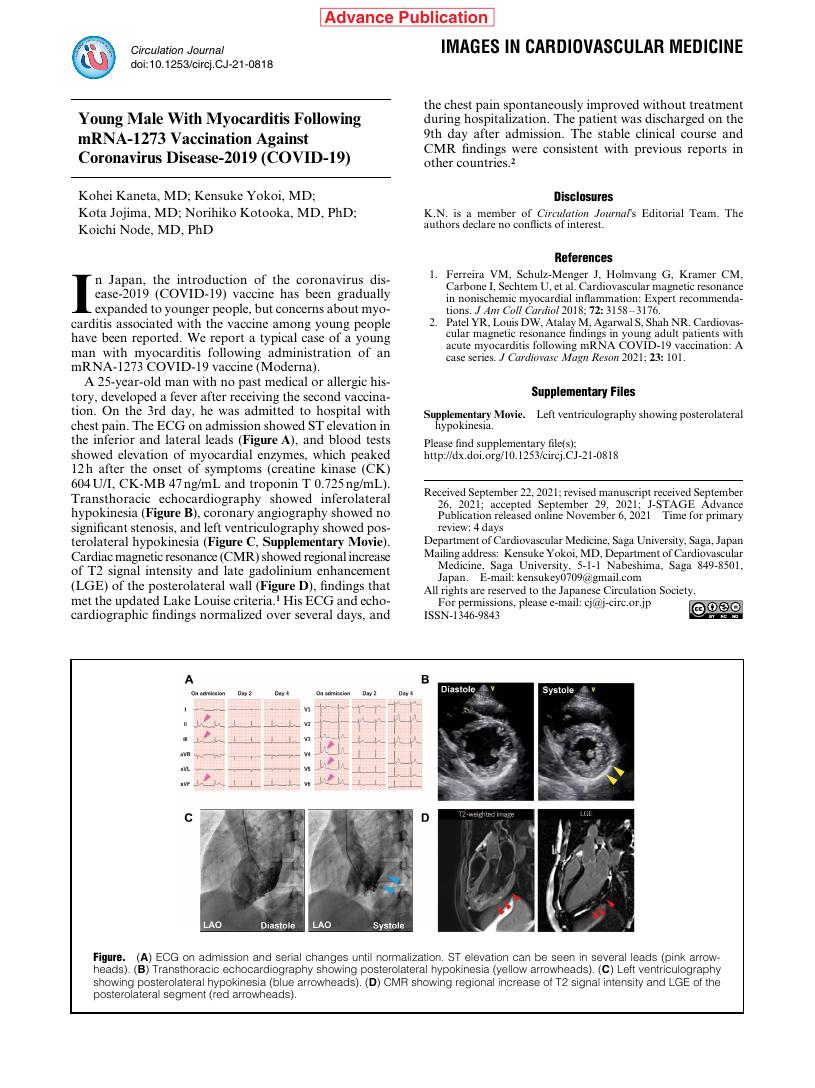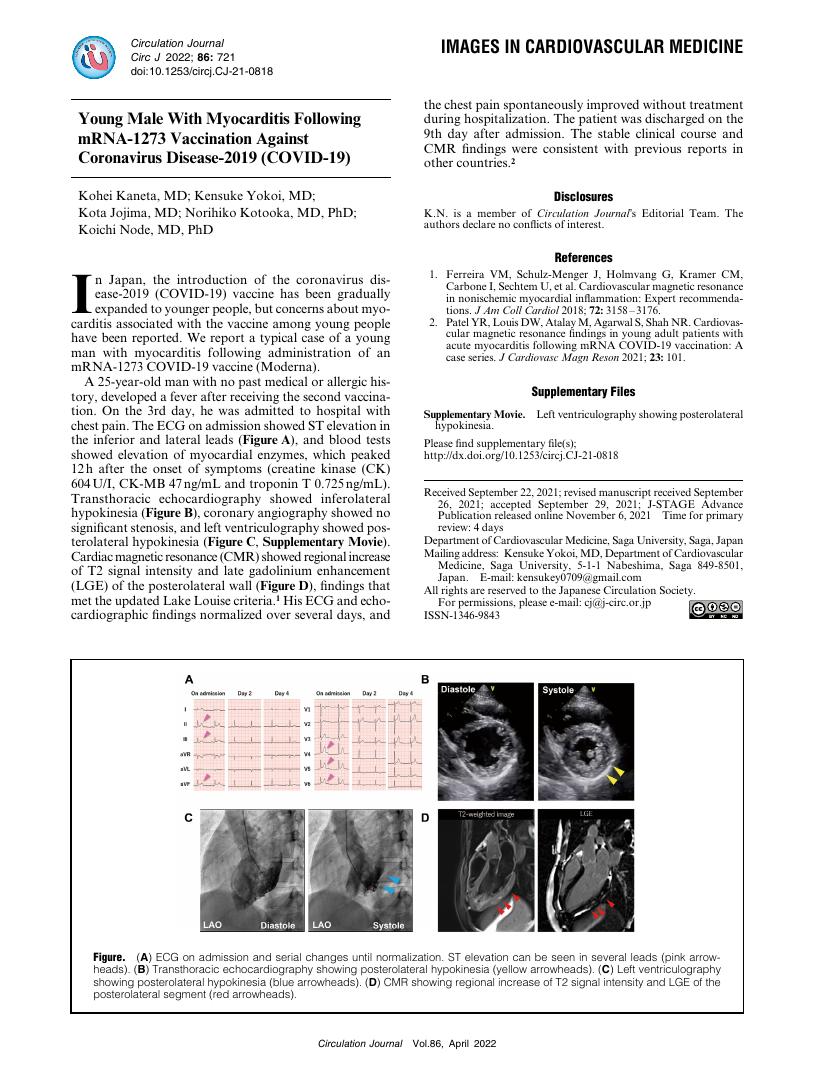238 0 0 0 OA Young Male With Myocarditis Following mRNA-1273 Vaccination Against Coronavirus Disease-2019 (COVID-19)
- 著者
- Kohei Kaneta Kensuke Yokoi Kota Jojima Norihiko Kotooka Koichi Node
- 出版者
- The Japanese Circulation Society
- 雑誌
- Circulation Journal (ISSN:13469843)
- 巻号頁・発行日
- pp.CJ-21-0818, (Released:2021-11-06)
- 参考文献数
- 2
- 被引用文献数
- 6
13 0 0 0 OA Young Male With Myocarditis Following mRNA-1273 Vaccination Against Coronavirus Disease-2019 (COVID-19)
- 著者
- Kohei Kaneta Kensuke Yokoi Kota Jojima Norihiko Kotooka Koichi Node
- 出版者
- The Japanese Circulation Society
- 雑誌
- Circulation Journal (ISSN:13469843)
- 巻号頁・発行日
- vol.86, no.4, pp.721, 2022-03-25 (Released:2022-03-25)
- 参考文献数
- 2
- 被引用文献数
- 1 6
- 著者
- Takashi Kuragaichi Yuma Kurozumi Shogo Ohishi Yasuo Sugano Akihiro Sakashita Norihiko Kotooka Makoto Suzuki Taiki Higo Dai Yumino Yasuko Takada Seiko Maeda Saori Yamabe Koichi Washida Tomonori Takahashi Tomohito Ohtani Yasushi Sakata Yukihito Sato
- 出版者
- The Japanese Circulation Society
- 雑誌
- Circulation Journal (ISSN:13469843)
- 巻号頁・発行日
- vol.82, no.5, pp.1336-1343, 2018-04-25 (Released:2018-04-25)
- 参考文献数
- 45
- 被引用文献数
- 16 26
Background:Palliative care for heart failure (HF) patients is recommended in Western guidelines, so this study aimed to clarify the current status of palliative care for HF patients in Japan.Methods and Results:A survey was sent to all Japanese Circulation Society-authorized cardiology training hospitals (n=1,004) in August 2016. A total of 544 institutions (54%) returned the questionnaire. Of them, 527 (98%) answered that palliative care is necessary for patients with HF. A total of 227 (42%) institutions held a palliative care conference for patients with HF, and 79% of the institutions had <10 cases per year. Drug therapy as palliative care was administered at 403 (76%) institutions; morphine (87%) was most frequently used. Among sedatives, dexmedetomidine (33%) was administered more often than midazolam (29%) or propofol (20%). Regarding the timing of end-of-life care, most institutions (84%) reported having considered palliative care when a patient reached the terminal stage of HF. Most frequently, the reason for the decision at the terminal stage was “difficulty in discontinuing cardiotonics.” A major impediment to the delivery of palliative care was “difficulty predicting an accurate prognosis.”Conclusions:This large-scale survey showed the characteristics of palliative care for HF in Japan. The present findings may aid in the development of effective end-of-life care systems.
- 著者
- Kentaro Kamiya Takanobu Yamamoto Miyuki Tsuchihashi-Makaya Toshimi Ikegame Tetsuya Takahashi Yukihito Sato Norihiko Kotooka Yoshihiko Saito Hiroyuki Tsutsui Hiroaki Miyata Mitsuaki Isobe
- 出版者
- The Japanese Circulation Society
- 雑誌
- Circulation Journal (ISSN:13469843)
- 巻号頁・発行日
- vol.83, no.7, pp.1546-1552, 2019-06-25 (Released:2019-06-25)
- 参考文献数
- 20
- 被引用文献数
- 15 70
Background:The purpose of this study was to clarify the implementation rate of multidisciplinary heart failure (HF) care and cardiac rehabilitation (CR) in Japan, as well as the relationship between implementation rates and characteristics of the facility.Methods and Results:Survey participants were cardiologists who are members of the Japan Heart Failure Society and belonged to 1 of 845 medical institutions that are members of the Japan Heart Failure Society, as of April 2016. A total of 288 institutions (34.1%) returned the questionnaire. The percentages of hospitals implementing multidisciplinary HF care were 78.5% for inpatients and 32.6% for outpatients with HF. Inpatient and outpatient CR for HF had implementation rates of 80.4% and 56.5%, respectively. In addition, very few HF patients (7.3%, 3,741/51,323 patients) received outpatient CR. Both the presence of nurses certified in chronic HF care and registered CR instructors on staff were consistently associated with implementation of multidisciplinary HF care, and Japanese Circulation Society training hospitals, lower number of hospital beds, and presence of registered CR instructors on staff were consistently associated with implementation of CR.Conclusions:This first nationwide survey demonstrated that the implementation rates of multidisciplinary care and CR for HF, especially for outpatients, are low in Japan. Skilled healthcare professionals are expected to play important roles in the widespread implementation of this type of HF care in Japan.
- 著者
- Kentaro Kamiya Takanobu Yamamoto Miyuki Tsuchihashi-Makaya Toshimi Ikegame Tetsuya Takahashi Yukihito Sato Norihiko Kotooka Yoshihiko Saito Hiroyuki Tsutsui Hiroaki Miyata Mitsuaki Isobe
- 出版者
- The Japanese Circulation Society
- 雑誌
- Circulation Journal (ISSN:13469843)
- 巻号頁・発行日
- pp.CJ-19-0241, (Released:2019-06-11)
- 参考文献数
- 20
- 被引用文献数
- 70
Background:The purpose of this study was to clarify the implementation rate of multidisciplinary heart failure (HF) care and cardiac rehabilitation (CR) in Japan, as well as the relationship between implementation rates and characteristics of the facility.Methods and Results:Survey participants were cardiologists who are members of the Japan Heart Failure Society and belonged to 1 of 845 medical institutions that are members of the Japan Heart Failure Society, as of April 2016. A total of 288 institutions (34.1%) returned the questionnaire. The percentages of hospitals implementing multidisciplinary HF care were 78.5% for inpatients and 32.6% for outpatients with HF. Inpatient and outpatient CR for HF had implementation rates of 80.4% and 56.5%, respectively. In addition, very few HF patients (7.3%, 3,741/51,323 patients) received outpatient CR. Both the presence of nurses certified in chronic HF care and registered CR instructors on staff were consistently associated with implementation of multidisciplinary HF care, and Japanese Circulation Society training hospitals, lower number of hospital beds, and presence of registered CR instructors on staff were consistently associated with implementation of CR.Conclusions:This first nationwide survey demonstrated that the implementation rates of multidisciplinary care and CR for HF, especially for outpatients, are low in Japan. Skilled healthcare professionals are expected to play important roles in the widespread implementation of this type of HF care in Japan.
- 著者
- Takashi Kuragaichi Yuma Kurozumi Shogo Ohishi Yasuo Sugano Akihiro Sakashita Norihiko Kotooka Makoto Suzuki Taiki Higo Dai Yumino Yasuko Takada Seiko Maeda Saori Yamabe Koichi Washida Tomonori Takahashi Tomohito Ohtani Yasushi Sakata Yukihito Sato
- 出版者
- The Japanese Circulation Society
- 雑誌
- Circulation Journal (ISSN:13469843)
- 巻号頁・発行日
- pp.CJ-17-1305, (Released:2018-03-10)
- 参考文献数
- 45
- 被引用文献数
- 26
Background:Palliative care for heart failure (HF) patients is recommended in Western guidelines, so this study aimed to clarify the current status of palliative care for HF patients in Japan.Methods and Results:A survey was sent to all Japanese Circulation Society-authorized cardiology training hospitals (n=1,004) in August 2016. A total of 544 institutions (54%) returned the questionnaire. Of them, 527 (98%) answered that palliative care is necessary for patients with HF. A total of 227 (42%) institutions held a palliative care conference for patients with HF, and 79% of the institutions had <10 cases per year. Drug therapy as palliative care was administered at 403 (76%) institutions; morphine (87%) was most frequently used. Among sedatives, dexmedetomidine (33%) was administered more often than midazolam (29%) or propofol (20%). Regarding the timing of end-of-life care, most institutions (84%) reported having considered palliative care when a patient reached the terminal stage of HF. Most frequently, the reason for the decision at the terminal stage was “difficulty in discontinuing cardiotonics.” A major impediment to the delivery of palliative care was “difficulty predicting an accurate prognosis.”Conclusions:This large-scale survey showed the characteristics of palliative care for HF in Japan. The present findings may aid in the development of effective end-of-life care systems.

